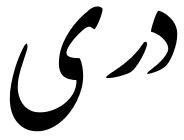Difference between revisions of "Language/Dari/Grammar/Conditional-Mood"
m (Quick edit) |
m (Quick edit) |
||
| Line 21: | Line 21: | ||
== Conclusion == | == Conclusion == | ||
We have looked at how to form the conditional mood in Dari, when to use it, and some examples of its use. With this knowledge, you should now be able to use the conditional mood correctly in your conversations. <br><hr>If you have any questions, please ask them in the comments section below.<br>Feel free to edit this wiki page if you think it can be improved. 😎 | We have looked at how to form the conditional mood in Dari, when to use it, and some examples of its use. With this knowledge, you should now be able to use the conditional mood correctly in your conversations. <br><hr>If you have any questions, please ask them in the comments section below.<br>Feel free to edit this wiki page if you think it can be improved. 😎 | ||
==Related Lessons== | |||
* [[Language/Dari/Grammar/Plurals|Plurals]] | |||
* [[Language/Dari/Grammar/Adjectives|Adjectives]] | |||
* [[Language/Dari/Grammar/Nouns|Nouns]] | |||
* [[Language/Dari/Grammar/Gender|Gender]] | |||
* [[Language/Dari/Grammar/Questions|Questions]] | |||
* [[Language/Dari/Grammar/Negation|Negation]] | |||
* [[Language/Dari/Grammar/Pronouns|Pronouns]] | |||
{{Dari-Page-Bottom}} | {{Dari-Page-Bottom}} | ||
Revision as of 23:01, 25 February 2023
Hi Dari learners! 😊
In today's lesson, we will be discussing the conditional mood in Dari. This is an important part of the language and understanding it will help you to communicate more effectively. We will look at how to form the conditional mood, when to use it, and some examples of its use.
Forming the Conditional Mood
The conditional mood in Dari is formed by adding the suffix -a to the verb stem. For example, the verb stem for 'to go' is gāh, so the conditional form would be gāha.
Irregular Verbs
There are some irregular verbs in Dari that have different forms in the conditional mood. For example, the verb stem for 'to be' is budan, but the conditional form is būda.
When to Use the Conditional Mood
The conditional mood is used to express a hypothetical situation or a wish. It can also be used to express a polite request.
Examples
- If I had more time, I would learn Dari. (Hypothetical situation)
- I wish I could speak Dari fluently. (Wish)
- Could you please help me with my Dari homework? (Polite request)
Conclusion
We have looked at how to form the conditional mood in Dari, when to use it, and some examples of its use. With this knowledge, you should now be able to use the conditional mood correctly in your conversations.
If you have any questions, please ask them in the comments section below.
Feel free to edit this wiki page if you think it can be improved. 😎
Related Lessons
